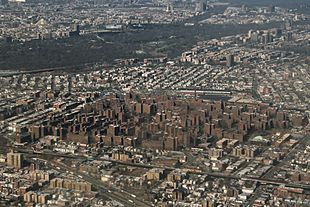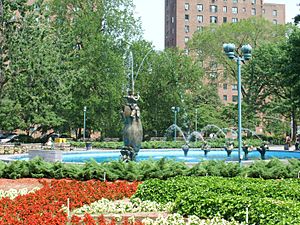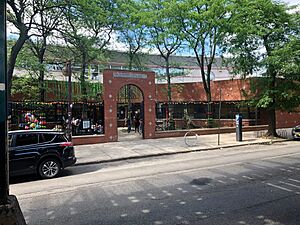Parkchester, Bronx facts for kids
Quick facts for kids
Parkchester
|
|
|---|---|
|
Neighborhood of the Bronx
|
|

The towers-in-the-park layout of Parkchester
|
|
| Country | |
| State | |
| City | New York City |
| Borough | The Bronx |
| Community District | The Bronx 9 |
| Area | |
| • Total | 0.329 sq mi (0.85 km2) |
| Population
(2020)
|
|
| • Total | 33,602 |
| • Density | 102,130/sq mi (39,430/km2) |
| Economics | |
| • Median income | $61,261 |
| Ethnicity | |
| • Hispanic | 33.0% |
| • Black | 35.1% |
| • White | 2.7% |
| • Asian | 25.4% |
| • Others | 3.8% |
| ZIP Codes |
10462, 10460, 10461
|
| Area code | 718, 347, 929, and 917 |
Parkchester is a special kind of neighborhood in the east Bronx, New York City. It's known as a planned community, which means it was designed and built all at once. The company that built it was the Metropolitan Life Insurance Company.
The area around the main apartment complex also uses the name Parkchester. Its borders are East Tremont Avenue to the north, Castle Hill Avenue to the east, Westchester Avenue to the south, and White Plains Road to the west. Important streets in Parkchester include Metropolitan Avenue, Unionport Road, and White Plains Road.
Parkchester is part of Bronx Community District 9. Most of it is in ZIP Code 10462, with smaller parts in 10460 and 10461. The 6 <6> trains subway line runs along Westchester Avenue, making it easy to get around. The neighborhood is kept safe by the New York City Police Department's 43rd Precinct, and the private housing complex has its own security team.
Contents
History of Parkchester
The Parkchester housing complex was built by MetLife, just like other large housing projects in Manhattan such as Stuyvesant Town–Peter Cooper Village. The name "Parkchester" comes from two nearby areas: Park Versailles and Westchester Heights.
At the 1939 New York World's Fair, MetLife showed off a detailed small model of Parkchester. This model was super accurate, even showing all 66,000 windows in the complex! The plan was to build 51 groups of buildings to house 12,000 families.
When it was first built from 1939 to 1942, Parkchester was meant to be a rental community for middle-class white families. At that time, the company had policies that limited who could live there. Over time, these policies changed, and Parkchester became a diverse community.
The complex was built on land that used to be a farm for the New York Catholic Protectory. This was a home for orphaned boys. In 1941, Macy's opened its first branch store outside of its main store in Parkchester.
In the 1970s and 1980s, parts of the complex were changed from rentals to condominiums. This meant people could buy their apartments instead of just renting them. Parkchester is famous for its wide, tree-lined paths and its unique terracotta decorations on the buildings. These decorations show animals and people and were made by artists like Joseph Kiselewski.
In 2015, Parkchester celebrated its 75th birthday with a big family event. More recently, in August 2024, the New York City Council voted to change zoning rules in Parkchester and nearby areas. This change is part of a project to improve train service and encourage new housing. Up to 7,000 new homes could be built in the area.
Parkchester Population and Diversity
Parkchester is a lively neighborhood with many people. According to the 2020 United States Census, about 33,602 people live here. This was a good increase from 2010, showing the neighborhood is growing.
The people living in Parkchester come from many different backgrounds. About 35.1% are African American, 25.4% are Asian, and 33.0% are Hispanic or Latino. There are also smaller groups of Non-Hispanic White residents and people from other backgrounds.
Parkchester has a large South Asian population, including people from Pakistan, Bangladesh, and India. You'll also find people of Italian, Polish, Irish, Eritrean, and Albanian heritage. Asian residents include people from Thailand, China, Japan, Vietnam, the Philippines, Myanmar, and Cambodia.
The neighborhood is also home to many Puerto Ricans. For example, Luis R. Sepulveda, who represents the area in the New York State Assembly, has his office on Westchester Avenue. Parkchester has one of the highest numbers of Puerto Ricans in New York City.
The community has a good mix of ages, with many young people and middle-aged adults. The average life expectancy in this area is about 79.7 years. In 2017, the average household income was around $40,005.
Land Use in Parkchester
The Parkchester complex has 171 brick buildings. They are either eight or 13 stories tall. The taller buildings have two elevators, while the shorter ones have one. Some apartments on the ground floor, called "Terrace" apartments, have a special screened door that opens onto a concrete patio.
The area around the complex, also called "Parkchester," has many other apartment buildings. Most homes here are rented. You can find shops and businesses all over the neighborhood, especially along Starling Avenue, McGraw Avenue, Metropolitan Avenue, Tremont Avenue, Unionport Road, and White Plains Road.
Some interesting places in Parkchester include:
- American Theater: This movie theater opened in 1939 but closed in 2013. It's now a Marshall's store.
- Macy's Department Store: This large store opened in 1941 and was Macy's first branch store outside its main location.
- Zaro's Bakery: This bakery opened in 1959. It closed for a while but reopened in 2017 near its original spot.
A special part of Parkchester is the Bangla Bazaar. It's a long stretch of blocks along Olmstead Avenue, Odell Street, Purdy Street, and Castle Hill Avenue. Many businesses here are owned by people from Bangladesh, making it a lively center for their community.
Parkchester has two main parts. The Parkchester Apartment Complex is the main housing area. Its borders are East Tremont Avenue, Castle Hill Avenue, McGraw Avenue, and White Plains Road. The apartments here have recently been updated. Stratton Park is another part, located on the west side of Parkchester. It's known for its green spaces.
At the very center of Parkchester is the Aileen B. Ryan Oval, a two-acre park that used to be called Metropolitan Oval.
Artwork in Parkchester
Parkchester was designed to be beautiful, with fancy brick patterns and art. The buildings have about 500 terra cotta statues and 600 plaques. These artworks show all sorts of figures, like bullfighters, soldiers, mermaids, and Native American chiefs. They also show many animals, such as gazelles, puffins, kangaroos, and bears.
Most of these sculptures were made by the Federal Seaboard Terra Cotta Corporation. Artists like Raymond Granville Barger, Joseph Kiselewski, Carl Schmitz, and Theodore Barbarossa worked on them. You can see their sculptures at building entrances and high up on the corners of taller buildings. Some are painted in bright colors.
In the Aileen B. Ryan Oval, there's a fountain called Fantasia, made by Raymond Granville Barger in 1941. It's a popular spot for photos. The old Loew's American Theater also has art, with figures of harlequins, a matador, a hula girl, and a flamenco dancer.
Some of these sculptures were removed between 2018 and 2021. Now, people who care about history and art are working to protect and save the remaining Parkchester sculptures.
Post Office and ZIP Codes
Parkchester uses a few different ZIP Codes. The main housing complex is in 10462. Areas just west are in 10460, and areas just east are in 10461. The United States Postal Service has a Parkchester Station located at 1449 West Avenue.
Education in Parkchester
When it comes to education, Parkchester has a similar number of college-educated residents as other parts of New York City. About 23% of adults aged 25 and older have a college degree or higher. Many residents are high school graduates or have some college education.
For younger students, about 28% of elementary school students in Parkchester miss twenty or more days of school each year. This is a bit higher than the city average. For high school students, about 69% graduate on time. This is a little lower than the city average of 75%.
Schools in Parkchester
Parkchester has several schools for different age groups:
- PS 106: A public elementary school for grades 1-5, located at 2120 St. Raymond Avenue.
- MS 127, the Castle Hill Middle School: A public middle school for grades 6-8, on St Raymond Avenue and Purdy Street. It has improved a lot and now uses different learning communities to help students succeed.
- St. Raymond Elementary School: A private elementary and middle school on Purdy Street, teaching students from pre-kindergarten to 8th grade.
- St. Raymond Academy for Girls: A private high school for girls in grades 9-12, located on Castle Hill Avenue.
- St. Raymond High School for Boys: A private high school for boys in grades 9-12, located on St Raymond Avenue.
- St. Helena Elementary: A private school on Benedict Avenue, teaching students from pre-kindergarten to 8th grade.
- Bronx Charter School for Excellence: A charter school on Benedict Avenue, for students from kindergarten to 8th grade.
Parkchester Library
The New York Public Library has a branch in Parkchester at 1985 Westchester Avenue. It first opened in 1942 within the Parkchester development and moved to its current two-story building in 1985. It's a great place to find books and learn!
Transportation in Parkchester
Getting around Parkchester and to other parts of New York City is easy with public transportation.
The following MTA Regional Bus Operations bus routes serve Parkchester:
- Bx4: Travels to Westchester Square or Third Avenue-149th Street.
- Bx4A: Travels to Westchester Square or Simpson Street.
- Bx11: Travels to George Washington Bridge Bus Terminal.
- Bx22: Travels to Bedford Park or Castle Hill.
- Bx36: Travels to Castle Hill or George Washington Bridge Bus Terminal.
- Bx39: Travels to Wakefield – 241st Street subway station or Clason's Point.
- Bx40: Travels to SUNY Maritime College or Morris Heights.
- Bx42: Travels to Throgs Neck or Morris Heights.
- Q44 SBS: Travels to Jamaica or West Farms.
- BxM6: An express bus to Midtown Manhattan.
The main New York City Subway station serving Parkchester is:
- Parkchester (6 <6> trains line)
Notable People from Parkchester
Many interesting people have lived in or are connected to Parkchester:
- Claudette Colvin (born 1939), a civil rights hero.
- Jim Larrañaga (born 1949), a well-known basketball coach.
- Alexandria Ocasio-Cortez (born 1989), a U.S. Representative.
- George A. Romero (1940–2017), a famous filmmaker.
- Claudia Goldin, a Nobel Prize winner.




